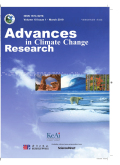- 钛学术文献服务平台 \
- 学术期刊 \
- 基础科学期刊 \
- 天文学、地球科学期刊 \
- 气候变化研究进展(英文版)期刊 \
Understanding the cold biases of CMIP5 models over China with weather regimes
Understanding the cold biases of CMIP5 models over China with weather regimes
基本信息来源于合作网站,原文需代理用户跳转至来源网站获取
摘要:
Most models in the fifth phase of the Coupled Model Intercomparison Project (CMIP5) underestimate the surface air temperature over China in both winter and summer.Understanding the weather regime in association with the simulated temperature variability is of high interest to get insight into those biases.Based on the weather regime method,we investigated the contributions of large-scale dynamics and non-dynamical processes to temperature biases and inter-model spread.The weather regimes associated with the observational temperature patterns were obtained through a k-means clustering algorithm applied to daily 500 hPa geopotential height anomalies.Here we identified the clustering number of weather regimes using the classifiability and reproducibility indices which can provide the optimal clustering number to obtain objective clustering.Both indices suggested the weather regimes in East Asia can be classified as four clusters in winter (Decem-ber-January-February) and three in summer (June--July--August).The results indicated that the first and second weather regimes were related to the cold temperature anomalies in China during winter,and the three weather regimes could not effectively classify the temperature patterns during summer.The ensemble mean of 23 CMIP5 models overestimated the occurrence frequencies of the second weather regime,which corresponds to a weaker high latitude westerly jet over East Asia during winter.The 500 hPa geopotential height anomalies and the inter-model spread over the Tibetan Plateau may be associated with the limited ability of the CMIP5 models in simulating the thermal effects of plateau in summer.We also found that the non-dynamical processes had major contribution to the ensemble-mean biases,and the large-scale dynamics played a minor role.The non-dynamical processes substantially affected the inter-model spread,especially over the Tibetan Plateau and the Sichuan Basin,during both winter and summer.The results suggested that improving the simulation of regional processes may help to improve model performance.The use of multi-model mean is recommended since it performs better than most of individual models.

推荐文章
5种CMIP5模拟降水数据在中国的适用性评估
气候变化
CMIP5模式
干旱指数
系统评估
干旱时空特征
水资源管理
CMIP5模式对长江流域气温模拟与预估
CMIP5
长江流域
气温
RCPs情景
杨楼流域降水变化特征及CMIP5气候模式评估
CMIP5
气候模式
降水
秩评分评估
杨楼流域
in CMIP5 models
CMIP5
气溶胶有效辐射强迫
温度变化
东亚
内容分析
关键词云
关键词热度
相关文献总数
(/次)
(/年)
文献信息
| 篇名 | Understanding the cold biases of CMIP5 models over China with weather regimes | ||
| 来源期刊 | 气候变化研究进展(英文版) | 学科 | |
| 关键词 | |||
| 年,卷(期) | 2021,(3) | 所属期刊栏目 | Changes in climate system |
| 研究方向 | 页码范围 | 373-383 | |
| 页数 | 11页 | 分类号 | |
| 字数 | 语种 | 英文 | |
| DOI | |||
五维指标
引文网络
引文网络
二级参考文献 (105)
共引文献 (195)
参考文献 (35)
节点文献
引证文献 (0)
同被引文献 (0)
二级引证文献 (0)
1957(1)
- 参考文献(0)
- 二级参考文献(1)
1981(1)
- 参考文献(0)
- 二级参考文献(1)
1983(1)
- 参考文献(1)
- 二级参考文献(0)
1988(1)
- 参考文献(0)
- 二级参考文献(1)
1989(1)
- 参考文献(0)
- 二级参考文献(1)
1993(1)
- 参考文献(1)
- 二级参考文献(0)
1994(1)
- 参考文献(0)
- 二级参考文献(1)
1995(3)
- 参考文献(2)
- 二级参考文献(1)
1996(1)
- 参考文献(1)
- 二级参考文献(0)
1997(1)
- 参考文献(1)
- 二级参考文献(0)
1998(1)
- 参考文献(0)
- 二级参考文献(1)
1999(2)
- 参考文献(2)
- 二级参考文献(0)
2001(3)
- 参考文献(1)
- 二级参考文献(2)
2002(3)
- 参考文献(0)
- 二级参考文献(3)
2003(3)
- 参考文献(0)
- 二级参考文献(3)
2004(2)
- 参考文献(0)
- 二级参考文献(2)
2005(7)
- 参考文献(2)
- 二级参考文献(5)
2006(5)
- 参考文献(0)
- 二级参考文献(5)
2007(12)
- 参考文献(4)
- 二级参考文献(8)
2008(3)
- 参考文献(0)
- 二级参考文献(3)
2009(5)
- 参考文献(0)
- 二级参考文献(5)
2010(15)
- 参考文献(1)
- 二级参考文献(14)
2011(5)
- 参考文献(0)
- 二级参考文献(5)
2012(12)
- 参考文献(3)
- 二级参考文献(9)
2013(14)
- 参考文献(3)
- 二级参考文献(11)
2014(13)
- 参考文献(5)
- 二级参考文献(8)
2015(2)
- 参考文献(0)
- 二级参考文献(2)
2016(9)
- 参考文献(3)
- 二级参考文献(6)
2017(4)
- 参考文献(1)
- 二级参考文献(3)
2018(1)
- 参考文献(0)
- 二级参考文献(1)
2019(3)
- 参考文献(1)
- 二级参考文献(2)
2020(3)
- 参考文献(2)
- 二级参考文献(1)
2021(1)
- 参考文献(1)
- 二级参考文献(0)
2021(1)
- 参考文献(1)
- 二级参考文献(0)
- 引证文献(0)
- 二级引证文献(0)
引文网络交叉学科
相关学者/机构
期刊影响力
气候变化研究进展(英文版)
主办单位:
国家气候中心
出版周期:
季刊
ISSN:
1674-9278
CN:
11-5918/ P
开本:
16开
出版地:
北京市中关村南大街46号国家气候中心
邮发代号:
创刊时间:
2010
语种:
eng
出版文献量(篇)
377
总下载数(次)
0
总被引数(次)
708
期刊文献
相关文献
推荐文献
- 期刊分类
- 期刊(年)
- 期刊(期)
- 期刊推荐
力学
化学
地球物理学
地质学
基础科学综合
大学学报
天文学
天文学、地球科学
数学
气象学
海洋学
物理学
生物学
生物科学
自然地理学和测绘学
自然科学总论
自然科学理论与方法
资源科学
非线性科学与系统科学
气候变化研究进展(英文版)2022
气候变化研究进展(英文版)2021
气候变化研究进展(英文版)2020
气候变化研究进展(英文版)2019
气候变化研究进展(英文版)2018
气候变化研究进展(英文版)2017
气候变化研究进展(英文版)2016
气候变化研究进展(英文版)2015
气候变化研究进展(英文版)2014
气候变化研究进展(英文版)2013
气候变化研究进展(英文版)2012
气候变化研究进展(英文版)2011
气候变化研究进展(英文版)2010
气候变化研究进展(英文版)2021年第6期
气候变化研究进展(英文版)2021年第4期
气候变化研究进展(英文版)2021年第3期
气候变化研究进展(英文版)2021年第2期
气候变化研究进展(英文版)2021年第1期

 免费查重
免费查重










